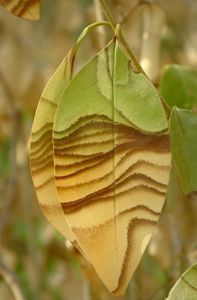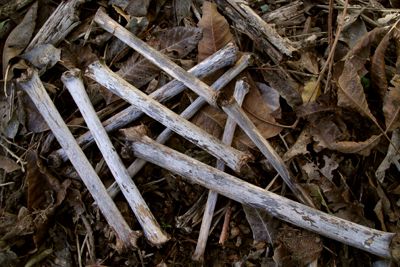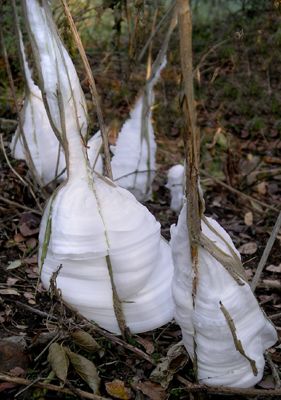
dead Ligustrum leaves
 dead Ligustrum leaves |
Mushrooms are well known for their ephemeral existence. When conditions are ideal, they rapidly grow, release their spores, and quickly deteriorate into a putrid mess. Some seem to melt, in a process called autodeliquescence, as their tissues digest themselves.
When plants die, they decompose just like animals or fungi. Sometimes. Small, tender herbs do turn brown, shrivel and eventually disintegrate into their more basic elements. However, trees have that sturdy scaffolding called a trunk, and the wood of which it is composed is tough enough to last a long, LONG time. If wood wasn't so enduring, we'd have a lot more houses made of rocks. Even the more fragile plants have stiffeners in them that, instead of just rotting away to almost nothing, remain in place as a dry, colorless framework. Whether up north where everything ends up under a thick layer of snow, or in southern regions where fields simply turn brown but otherwise look pretty much the same, grasses, annual herbs, ferns, and other low growing plants leave behind the bulk of their forms, minus the green bits.
 Four O'clock "bones" |
Even the toughest plant parts eventually decompose, with the help of microbes and animals capable of digesting cellulose. But the process of decomposition often takes rather longer with plants than it does with animals or fungi. Most vegetation quietly rots away without any notable phenomena to grab our attention. There are exceptions.
Among native plant aficionados, Ligustrum is a four-letter word. This exotic tough-leaved evergreen shrub is a favorite with low-cost landscapers, since it survives well, looks like a typical nondescript decorative bush, and can be pruned into any shape desired. What is not desirable is that it easily escapes into the wild, where its rapid growth pushes out the diverse native plant community, depriving the animal populations of essential food. While birds might nest in a Ligustrum, they will not find the caterpillars and other insects that they feed to their young in the same kind of plant. Nature preserves and other wild areas near cultivated suburban yards are sometimes overrun with this invader. While it seems that nothing can kill Ligustrum, our recent record-breaking drought proved that assumption false.
In the summer of 2011, central Texas experienced its most severe drought in decades. No rain and a string of extraordinarily hot days taxed even the most hardy of plants. Ligustrum was pushed beyond its limits. I had never seen it die from lack of water before, but the end result was quite interesting. The leaves turned shades of pale green, gold and brown, but they did so in a unique pattern, as if each day a little more of the leaf died, resulting in a series of bands that looked like water rings on rocks, agate, or those jars filled with layers of different colored sands. Each leaf looked like a miniature picture of a landscape, with all the delicacy and interest of an artistic Japanese painting.
 Frostweed ice formations |
One of the most impressive displays of a dead plant occurs with our native Frostweed (Verbesina virginica). This perennial forms colonies at the forest edge, usually under large oak trees. The plants grow to about three or four feet every year, producing broad leaves on thick stems. In the fall, the clusters of small white flowers provide nectar for all manner of bees, flies, butterflies and moths. As the season winds down, the leaves drop and the stems turn brown. They are easily forgotten as they blend in with other undergrowth plant remnants. But in the morning after the first hard freeze, the Frostweed puts on a display that certainly draws attention. Sheets and ribbons of ice erupt from the base of the stems, splitting the outer stem covering and looking for all intents and purposes just like glistening Styrofoam. The curls, bulges, and layers of ice remind me of gypsum crystals in caves, frosted blown glass, or sparklingly delicate reef corals. Sometimes there is a lesser display after the second freeze, but in my experience only the first produces stunning results. Other people report that they've seen the same species exude frost many times in a single winter, so I suspect that my tolerance for chilly morning walks simply wanes with the prolonged cold period and that's why I have not noticed subsequent Frostweed displays.
Plants are such an ubiquitous part of our environment that they often go unnoticed. When they do take center stage, it is usually due to colorful flowers or the autumn changes in leaves. That a few species are attention-grabbing even as they decay in death is just more evidence of the remarkable variety of fascinating things that occur in nature around us all the time. We need only look.